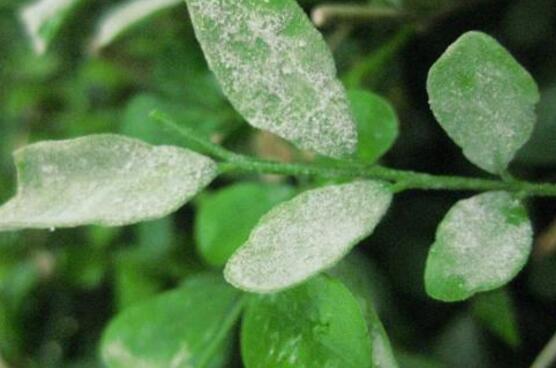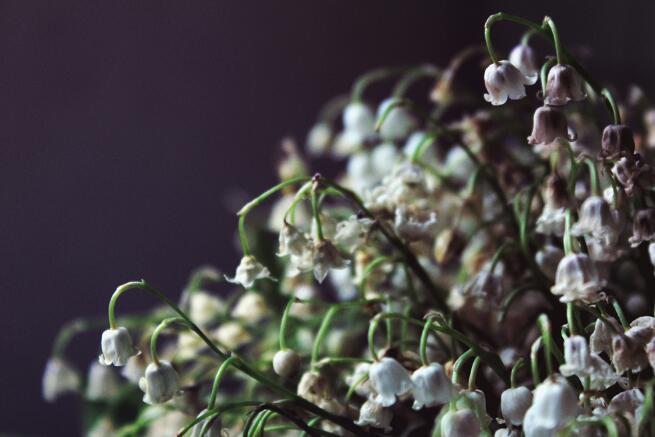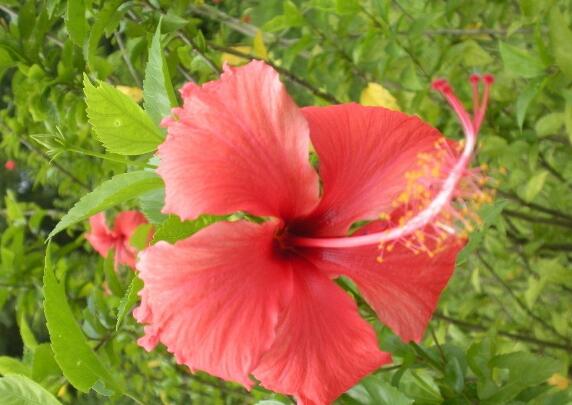What should we do when insects grow in Jiuli incense? disease and pest control of Jiuli incense / 3 insects and 3 diseases are sprayed with medicine
Jiuli incense, a very ornamental plant, is very popular with flower friends because of its frequent flowering period and charming scenery when it blossoms. In life, many flower friends keep Jiuli incense, but because of careless maintenance and other reasons, will attract diseases and insect pests, that Jiuli incense leaves worms how to do? The following is the pest control of Jiuli incense. If you love flowers, you must have a look.
One, nine incense leaves grow worms, spray with medicine

As a good product of indoor farming, many people keep Jiuli incense at home, but if they do not raise it according to the breeding method of Jiuli incense, it will grow worms and get sick. Flower friends must be very worried! As for what to do about the worms in Jiuli incense, we should determine which kind of bugs it is, and then solve the problem. In the prevention and control of diseases and insect pests of Jiuli incense, the editor talks about pests and diseases respectively.
(1) diseases and insect pests of Jiuli incense, 3 insect pests
Red spider, light shield green longicorn beetle, sagittal shield scale
1. Red spider
This insect is one of the main pests of Jiuli incense. It harms the leaves of the plant and survives by sucking on the leaf juice of Jiuli incense. Symptoms of damage: the plant will become malnourished, and the yellowing of incense leaves will appear.
Solution: if there are few red spiders, you can directly remove the leaves and clean them up; for a long time, red spiders should be sprayed with drugs in time, and 2000 times of triclofenac EC can be sprayed several times more.
2. Light shield green longicorn beetle
One of the diseases and insect pests of Jiuli incense, which harms the shoots of the plant. Symptoms of being violated: the branches of Jiuli incense can be easily broken or slowly withered to death.
Solution: after the above symptoms are found, dichlorvos EC of 50-80 times can be injected into the hole at the bottom of the branch, and the hole is sealed with soil after injection; in June-July, adults of longicorn beetles are found, and we can spray 2000 times of imidacloprid to destroy them.
3. The sagittal point shield scale
This insect mainly harms the tender leaves of Jiuli incense and sucks the sap of flowers. Symptoms of damage: the leaves of Jiuli incense changed from green to grayish green and finally turned to yellow. in serious cases, the branches and leaves were covered with shell insects, causing the whole plant to die.
Solution: if there are a small number of scale insects, they can be scraped directly or picked out with toothpicks; if the scale insects are dense, they can be sprayed with 50% marathon and 40% dimethoate 0.1% solution.
(2) Diseases and insect pests of Jiuli incense, 3 diseases
Powdery mildew, gray spot, leaf blight
With regard to the leaf worm of Jiuli incense, I believe we all know how to deal with it after reading the above content. However, in addition to being attacked by insects, the disease also endangers Jiuli incense all the time. It is understood that there are three main diseases: powdery mildew, gray spot and leaf blight. The specific symptoms and control methods are as follows:
1. Powdery mildew
One of the main diseases of Jiuli incense, which mainly harms the leaves of plants. Symptoms: at the beginning, there are small yellow spots on the surface of the leaves, followed by white powdery substances; at the end of the day, Jiuli incense will stop growing and even fail to bear fruit without a meeting.
Solution: when the above symptoms are found, 50% sulfur suspension 300 times 400 times can be sprayed; when the condition is serious, the shoots of seriously diseased plants are properly trimmed, and 29% azine 800 times solution is sprayed once every 7 to 10 days, and can be recovered after a few times.
2. Grey spot
The disease mainly harms the leaves of Jiuli incense, resulting in plaques with a diameter of 1mm to 6mm. Symptoms: in the early stage, the leaf appeared brown-black round or oval spot, the edge of the spot was dark, slightly raised on both sides; in the later stage, the middle of the leaf became white and small black spots appeared on the surface.
Solution: when you find the above symptoms, you should spray immediately. You can choose to spray 60% Dyson zinc wettable powder 600 times 800 times, which can be solved by spraying several times in succession.
3. Leaf blight
Another kind of Jiuli incense is one of the diseases and insect pests, which mainly harms the leaves and, in serious cases, spreads to the shoots and tender stems. Disease symptoms: in the initial stage, the disease spot of the leaf is faded green, and then infects the whole leaf, making the leaf turn yellowish brown. In the later stage, the leaves were dry and covered with black grains.
Solution: when the above symptoms are found, 70% methyl topiramate 1500 times solution or 65% Dysen zinc wettable powder solution can be sprayed for prevention and treatment.
With regard to the prevention and control of diseases and insect pests in Jiulixiang, the editor has introduced this. I believe that when we encounter the above-mentioned diseases in the future, we should know how to do it! Generally speaking, in the process of the growth of Jiulixiang, diseases and insect pests are inevitable, so for unnecessary trouble, flower friends should keep the above methods in mind.
Control methods of diseases and insect pests of Jiuli incense
Jiuli incense is a common plant, which is generally planted in the courtyard, and there are also potted plants planted in the home. Improper maintenance of Jiuli incense will cause various insect diseases. Today, I would like to introduce to you the prevention and control methods of diseases and insect pests.
Prevention and control methods of diseases and insect pests of Jiuli incense:
1. Red spiders: red spiders occur when the temperature is high, adsorbing on the leaves to suck juice, making the plants malnourished, causing leaves to lose green and yellowing, resulting in a large number of fallen leaves.
Solution: easy to occur in high temperature and drought, should pay attention to check the leaves, it is found that there are needle-sized red bugs on the leaf surface and back when crawling, it is necessary to continuously spray 1000 foliar aqueous solution for 2 or 3 times, or 1500 times of mites, that is, stagnant water; hold liquid, or 2000 times desulfuric water solution for prevention and control, spray every 10 to 15 days. Home potted Jiuli incense can be sprayed with 25 times 30 times red pepper aqueous solution or 25 times 30 times dry tobacco leaf extract, or wet the leaves with clean water and sprinkle with a layer of sulfur powder.
2. Longicorn beetles: longicorn beetles enter the damage from the epidermis and form insect paths, which weakens the tree. When it is serious, the branches and branches are broken, and even die.
Solution: in the growing season, we should pay attention to check the branches and shoots frequently, and find wormholes when insect feces are excreted, and then dip cotton into dichlorvos solution to block the wormhole mouth, so that the branch-tip longicorn beetles are suffocated in the wormpath. In the season of spawning and hatching of longicorn beetles, usually in autumn, the eggs and newly hatched larvae can be killed by spraying Lesbon solution or 1000 times poisonous spawn solution on the branches and shoots every 7-10 days.
3. Scale insects: scale insects absorb tree sap and cause coal fouling disease, resulting in poor growth of trees, withered and yellow branches and leaves and early defoliation. It can be wiped out manually or sprayed with dimethoate, trichlorfon and dichlorvos.
4. Beetles and butterflies: beetles and butterflies are mainly harmful leaves, mainly gnawing on tender leaves, reducing leaves, weakening tree potential and affecting normal growth.
Solution: during the growth of young leaves, you can spray 800x trichlorfon aqueous solution or 1000 times once purified water solution for control. Family potted Jiuli incense can be controlled by artificial capture, and the captured pests can be scalded to death with hot water.
5. Leaf roll moths and aphids: leaf roll moths and aphids mainly harm young leaves, withering and dying leaves after curling, or shrinking their growth points, thus affecting the normal growth of leaves.
Solution: during the growth of tender leaves, 1500-fold pure water solution of aphid lice, or 1500-fold aqueous solution of Dachongchen, or 1500-fold Anlubao aqueous solution can be sprayed to control and kill larvae.
6. Powdery mildew: powdery mildew occurs in leaves. It can be controlled by spraying azoxystrobin, triadimefon, thiophanate methyl and so on.
7. Iron rust: iron rust is a common disease of branches and stems, which causes the heart of branches to rot. It can be sprayed with triadimefon.
The cultivation of Jiuli incense needs to pay more attention to avoid diseases and insect pests, affecting the growth and ornamental value of Jiuli incense. I hope it will be helpful to you.
The main control methods of diseases and insect pests of Jiuli incense 1. Powdery mildew is often covered with white powdery matter on the leaf surface and back, making the leaves green, yellowing and shedding, causing serious damage during the emergence of new shoots. Rain Water is more, when the humidity is high, it is very easy to get sick and spread rapidly. During the budding period of the new shoots, the new shoots and leaves must be sprayed with 1500-fold cloclobupromazole aqueous solution, or 800-fold trimethoprim aqueous solution, or 1000-fold white powder water solution, etc. spray all branches and leaves evenly (it is advisable to start dripping with water drops). When Rain Water has more and more humidity, it is necessary to seize the sunny day and spray the 800-fold methyl topiramate aqueous solution in time. Home potted Jiuli incense can be sprayed with 25% 30 times dry pure plant ash extract, or 0.1% potassium permanganate aqueous solution, or 0.5% sodium bicarbonate aqueous solution, or 25% 30 times dry star anise extract or 0.1% lime water clarification solution, so as to be non-toxic, non-irritating and will not pollute the environment. If it rains four hours after spraying, it should be sprayed again to improve the control effect. Second, the red spider is harmful to the leaves, adsorbing and sucking sap on the leaves, making the plants malnourished, causing the leaves to lose green and yellowing, resulting in a large number of fallen leaves. It is easy to occur in high temperature and drought. When it is found that there are needle-sized red bugs on the leaf surface and back, it is necessary to spray 1000 foliage solution or 1500 times mite solution continuously for 2 times or 3 times, or 2000 times to prevent and cure it, spraying every 10 times 15 days. Home potted Jiuli incense can be sprayed with 25 times 30 times red pepper aqueous solution or 25 times 30 times dry tobacco leaf extract, or wet the leaves with clean water and sprinkle with a layer of sulfur powder. Third, the shoot longicorn beetle harms the branches and shoots, and enters the damage from the epidermis, forming a worm path, which weakens the tree, and when it is serious, the branches and branches are broken, even withered. In the growing season, we should pay attention to check the branches and shoots frequently, and find wormholes when insect feces are excreted, and then use cotton to dip dichlorvos in the original solution to block the wormhole, so that the shoot longicorn beetles are suffocated in the insect path. In the season of spawning and hatching of longicorn beetles, usually in autumn, the eggs and newly hatched larvae can be killed by spraying Lesbon solution or 1000 times poisonous spawn solution on the branches and shoots every 7-10 days. Fourth, beetles and butterflies are harmful to leaves, mainly gnawing on tender leaves, reducing leaves, weakening tree potential and affecting normal growth. During the growth of young leaves, it can be sprayed with 800x trichlorfon aqueous solution or 1000 times purified aqueous solution for control. Family potted Jiuli incense can be controlled by artificial capture, and the captured pests can be scalded to death with hot water. Fifth, the leaf roll moth and aphids damage the tender leaves, withering the leaves after curling, or shrinking the growth point, thus affecting the normal growth of the leaves. During the growth of tender leaves, 1500-fold pure water solution of aphid lice, or 1500-fold aqueous solution of great meritorious heroes, or 1500-fold Anlubao aqueous solution can be sprayed to control and kill larvae.
- Prev

Is it easy for the lily of the valley to grow insects? The pest control of the lily of the valley/1 pest 3 disease
Lily of the valley is a kind of ornamental plant, which originated from northeast China. However, if the beautiful flowers encounter pests and diseases, it will still affect their beauty, and it is more likely to cause the plants to wither and die. So is the lily of the valley prone to worms? If not properly maintained, there will still be long insects
- Next

What if the mulberry flowers grow worms? the disease and pest control of mulberry flowers / anthracnose should be sprayed.
Fusang flower, a very strong ornamental plant, has a long flowering period, its fiery red flowers are particularly charming, and are deeply loved by flower friends. However, when potted mulberry flowers are planted at home, some bugs often appear, which annoys many flower friends. What should we do if the mulberry flowers grow worms?
Related
- Fuxing push coffee new agricultural production and marketing class: lack of small-scale processing plants
- Jujube rice field leisure farm deep ploughing Yilan for five years to create a space for organic food and play
- Nongyu Farm-A trial of organic papaya for brave women with advanced technology
- Four points for attention in the prevention and control of diseases and insect pests of edible fungi
- How to add nutrient solution to Edible Fungi
- Is there any good way to control edible fungus mites?
- Open Inoculation Technology of Edible Fungi
- Is there any clever way to use fertilizer for edible fungus in winter?
- What agents are used to kill the pathogens of edible fungi in the mushroom shed?
- Rapid drying of Edible Fungi

